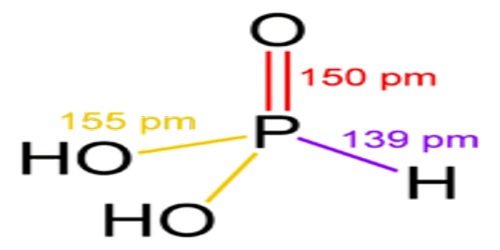Phosphonate
Definition
Phosphonate is a salt or an ester of one of a family of phosphonic acids. A variety of phosphonates occur naturally in many organisms, including plants. Phosphonic acids, typically handled as salts, are generally nonvolatile solids that are poorly soluble in organic solvents, but soluble in water and common alcohols. The simplest unsubstituted phosphonic acid is H-(PO)-(OH)2, a crystalline white solid obtained by reacting phosphorous trioxide with water.

Many commercially important compounds are phosphonates, including glyphosate, the herbicide “Roundup”, and ethephon, a widely used plant growth regulator. Bisphosphonates are popular drugs for treatment of osteoporosis.
In biology and medicinal chemistry, phosphonate groups are used as stable bioisoteres for phosphate, such as in the antiviral nucleotide analogue, Tenofovir, one of the cornerstones of anti-HIV therapy.
The primary metabolic functions of phosphonates in organisms include cell signaling, metabolism of cell membrane molecules, and the biological synthesis of naturally produced antibiotics. Some bacteria, fungi, and yeasts can break down phosphonates so they can use them as a food source and/or a form of usable phosphorus.

Production and Properties of Phosphonate
Most processes begin with phosphorous acid (aka phosphonic acid, H3PO3), exploiting its reactive P−H bond.
Phosphonic acid can be alkylated under Mannich conditions to give aminomethylated phosphonates, which are useful as complexants. One example is the industrial preparation of nitrilotris (methylenephosphonic acid):
NH3 + 3 H3PO3 + 3 CH2O → N(CH2PO3H2)3 + 3 H2O
Phosphonic acid also can be alkylated with acrylic acid derivatives to afford carboxyl functionalized phosphonic acids. This reaction is a variant of the Michael addition:
CH2=CHCO2R + 3 H3PO3 → (HO)2P(O)CH2CH2CO2R
Derivatives of the simplest phosphonic acid, such as the above structures, leave the hydrogen atom attached directly to the phosphorous untouched. It can be replaced, however. One simple example of this is methylphosphonic acid, CH3PO-(OH)2, in which the hydrogen is replaced by a methyl group, CH3. The disodium salt of methylphosphonic acid is written CH3PO-(ONa)2, while the structure of the diethyl ester diethyl methylphosphonate is written CH3PO-(OC2H5)2. Aryl derivatives can also be made, in which the hydrogen is replaced by an aromatic organic structure, such as phenyl (-C6H5), naphthyl (-C10H7) or p-tolyl (C6H4CH3).
The naturally occurring phosphonate 2-aminoethylphosphonic acid was first identified in 1959 in plants and many animals, where it is localized in membranes. Phosphonates are quite common among different organisms, from prokaryotes to eubacteria and fungi, mollusks, insects and others. They were first reported in natural soils by Newman and Tate (1980). The biological role of the natural phosphonates is still poorly understood. Bis- or polyphosphonates have not been found to occur naturally.

Uses of Phosphonate
Phosphonates are highly soluble in water, exhibit strong adsorption, have the ability to sequester (chelate) metal ions, and the ability to modify hard-water deposits. They show resistance to corrosion and oxidation, and remain stable under harsh conditions such as acidity and extreme temperatures. Phosphonates are also compatible with other chemicals and components in detergents.
Many commercial products contain phosphonates, including glyphosate, the herbicide Roundup, and ethephon, which is a widely used plant growth regulator. Bisphosphonates are popular for use as a treatment of osteoporosis.
Reference
















